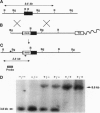Abstract
The renin-angiotensin system plays a critical role in sodium and fluid homeostasis. Genetic or acquired alterations in the expression of components of this system are strongly implicated in the pathogenesis of hypertension. To specifically examine the physiological and genetic functions of the type 1A receptor for angiotensin II, we have disrupted the mouse gene encoding this receptor in embryonic stem cells by gene targeting. Agtr1A(-/-) mice were born in expected numbers, and the histomorphology of their kidneys, heart, and vasculature was normal. AT1 receptor-specific angiotensin II binding was not detected in the kidneys of homozygous Agtr1A(-/-) mutant animals, and Agtr1A(+/-) heterozygotes exhibited a reduction in renal AT1 receptor-specific binding to approximately 50% of wild-type [Agtr1A(+/+)] levels. Pressor responses to infused angiotensin II were virtually absent in Agtr1A(-/-) mice and were qualitatively altered in Agtr1A(+/-) heterozygotes. Compared with wild-type controls, systolic blood pressure measured by tail cuff sphygmomanometer was reduced by 12 mmHg (1 mmHg = 133 Pa) in Agtr1A(+/-) mice and by 24 mmHg in Agtr1A(-/-) mice. Similar differences in blood pressure between the groups were seen when intraarterial pressures were measured by carotid cannulation. These studies demonstrate that type 1A angiotensin II receptor function is required for vascular and hemodynamic responses to angiotensin II and that altered expression of the Agtr1A gene has marked effects on blood pressures.
Full text
PDF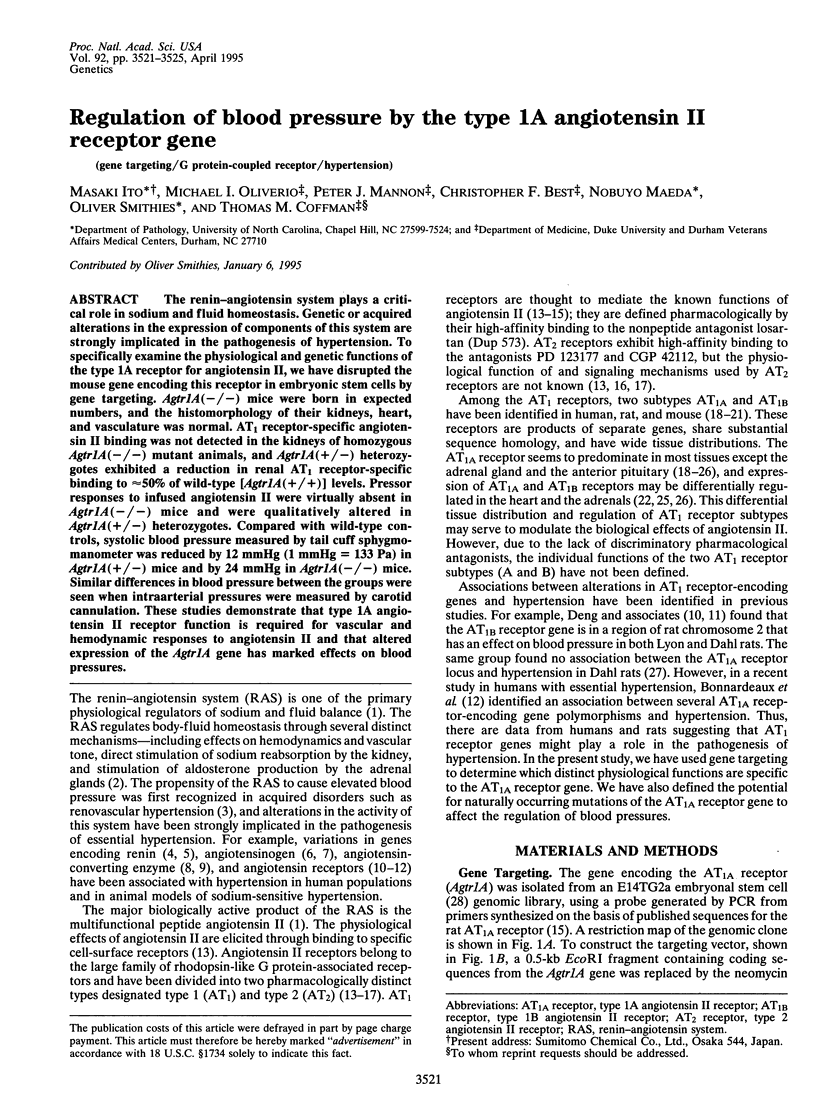
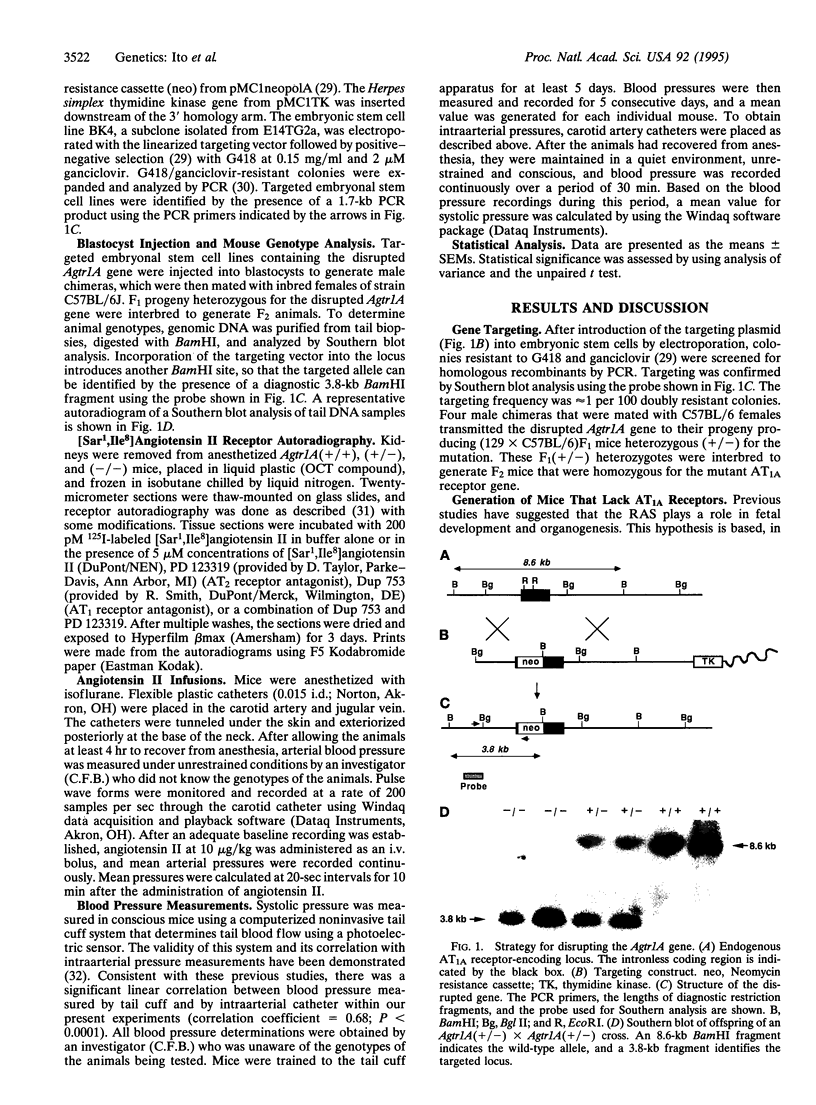
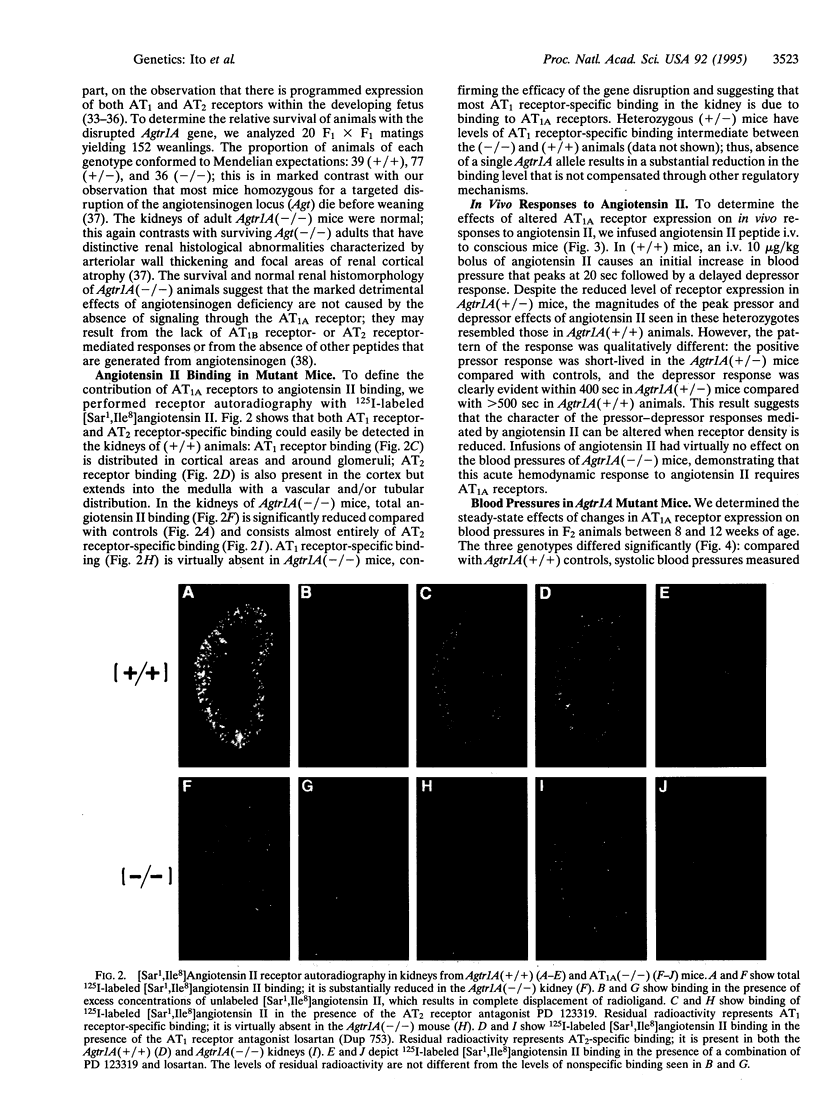
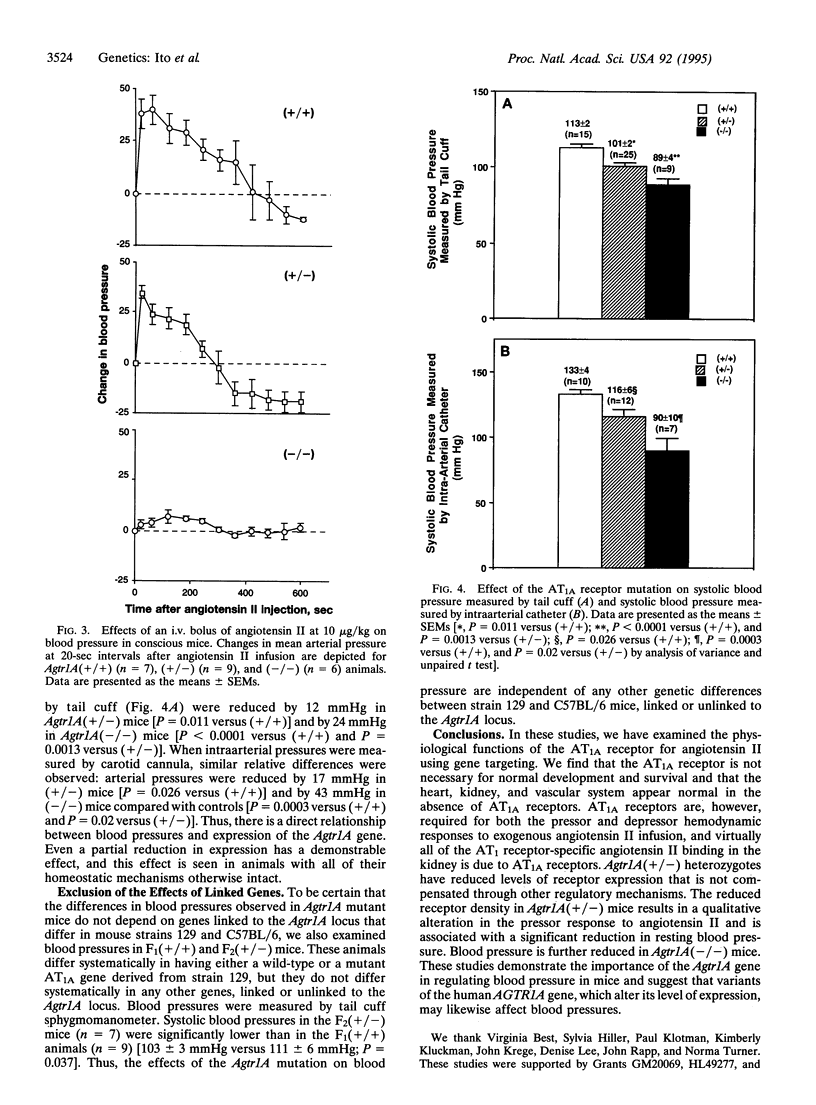
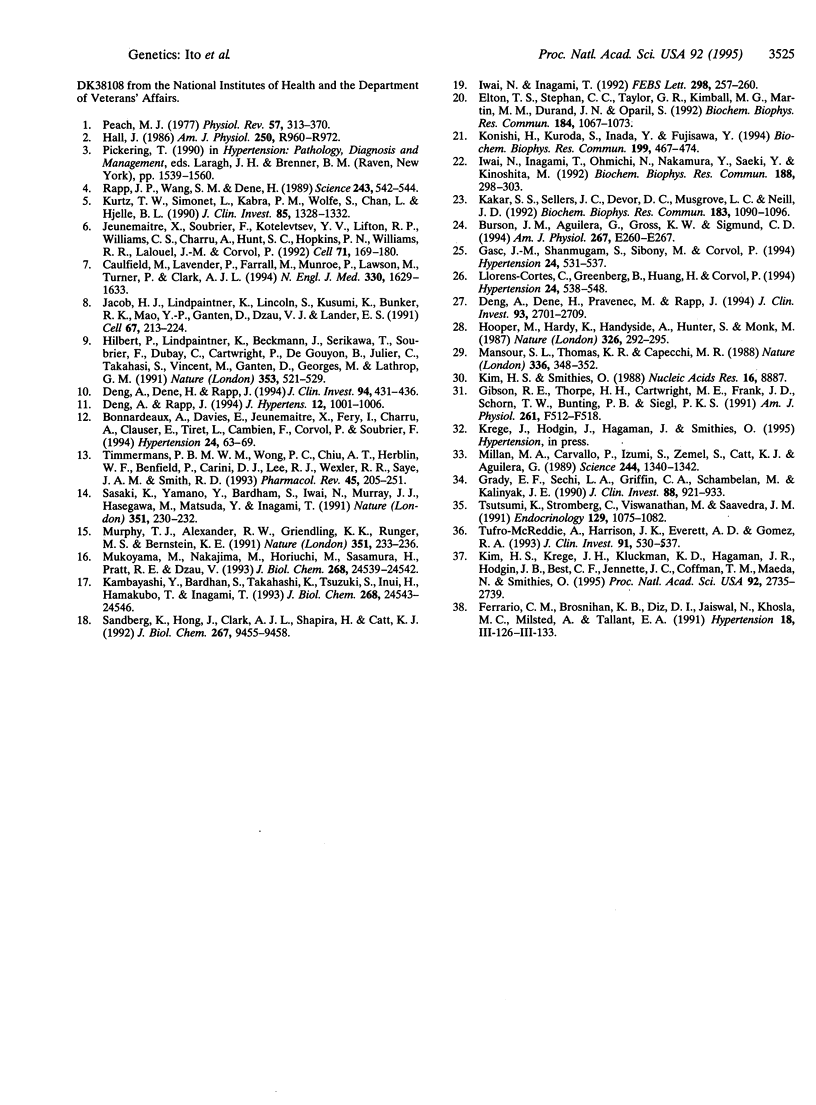
Images in this article
Selected References
These references are in PubMed. This may not be the complete list of references from this article.
- Bonnardeaux A., Davies E., Jeunemaitre X., Féry I., Charru A., Clauser E., Tiret L., Cambien F., Corvol P., Soubrier F. Angiotensin II type 1 receptor gene polymorphisms in human essential hypertension. Hypertension. 1994 Jul;24(1):63–69. doi: 10.1161/01.hyp.24.1.63. [DOI] [PubMed] [Google Scholar]
- Burson J. M., Aguilera G., Gross K. W., Sigmund C. D. Differential expression of angiotensin receptor 1A and 1B in mouse. Am J Physiol. 1994 Aug;267(2 Pt 1):E260–E267. doi: 10.1152/ajpendo.1994.267.2.E260. [DOI] [PubMed] [Google Scholar]
- Caulfield M., Lavender P., Farrall M., Munroe P., Lawson M., Turner P., Clark A. J. Linkage of the angiotensinogen gene to essential hypertension. N Engl J Med. 1994 Jun 9;330(23):1629–1633. doi: 10.1056/NEJM199406093302301. [DOI] [PubMed] [Google Scholar]
- Deng A. Y., Dene H., Pravenec M., Rapp J. P. Genetic mapping of two new blood pressure quantitative trait loci in the rat by genotyping endothelin system genes. J Clin Invest. 1994 Jun;93(6):2701–2709. doi: 10.1172/JCI117284. [DOI] [PMC free article] [PubMed] [Google Scholar]
- Deng A. Y., Dene H., Rapp J. P. Mapping of a quantitative trait locus for blood pressure on rat chromosome 2. J Clin Invest. 1994 Jul;94(1):431–436. doi: 10.1172/JCI117341. [DOI] [PMC free article] [PubMed] [Google Scholar]
- Deng A. Y., Rapp J. P. Evaluation of the angiotensin II receptor AT1B gene as a candidate gene for blood pressure. J Hypertens. 1994 Sep;12(9):1001–1006. [PubMed] [Google Scholar]
- Elton T. S., Stephan C. C., Taylor G. R., Kimball M. G., Martin M. M., Durand J. N., Oparil S. Isolation of two distinct type I angiotensin II receptor genes. Biochem Biophys Res Commun. 1992 Apr 30;184(2):1067–1073. doi: 10.1016/0006-291x(92)90700-u. [DOI] [PubMed] [Google Scholar]
- Gasc J. M., Shanmugam S., Sibony M., Corvol P. Tissue-specific expression of type 1 angiotensin II receptor subtypes. An in situ hybridization study. Hypertension. 1994 Nov;24(5):531–537. doi: 10.1161/01.hyp.24.5.531. [DOI] [PubMed] [Google Scholar]
- Gibson R. E., Thorpe H. H., Cartwright M. E., Frank J. D., Schorn T. W., Bunting P. B., Siegl P. K. Angiotensin II receptor subtypes in renal cortex of rats and rhesus monkeys. Am J Physiol. 1991 Sep;261(3 Pt 2):F512–F518. doi: 10.1152/ajprenal.1991.261.3.F512. [DOI] [PubMed] [Google Scholar]
- Grady E. F., Sechi L. A., Griffin C. A., Schambelan M., Kalinyak J. E. Expression of AT2 receptors in the developing rat fetus. J Clin Invest. 1991 Sep;88(3):921–933. doi: 10.1172/JCI115395. [DOI] [PMC free article] [PubMed] [Google Scholar]
- Hall J. E. Control of sodium excretion by angiotensin II: intrarenal mechanisms and blood pressure regulation. Am J Physiol. 1986 Jun;250(6 Pt 2):R960–R972. doi: 10.1152/ajpregu.1986.250.6.R960. [DOI] [PubMed] [Google Scholar]
- Hilbert P., Lindpaintner K., Beckmann J. S., Serikawa T., Soubrier F., Dubay C., Cartwright P., De Gouyon B., Julier C., Takahasi S. Chromosomal mapping of two genetic loci associated with blood-pressure regulation in hereditary hypertensive rats. Nature. 1991 Oct 10;353(6344):521–529. doi: 10.1038/353521a0. [DOI] [PubMed] [Google Scholar]
- Hooper M., Hardy K., Handyside A., Hunter S., Monk M. HPRT-deficient (Lesch-Nyhan) mouse embryos derived from germline colonization by cultured cells. Nature. 1987 Mar 19;326(6110):292–295. doi: 10.1038/326292a0. [DOI] [PubMed] [Google Scholar]
- Iwai N., Inagami T. Identification of two subtypes in the rat type I angiotensin II receptor. FEBS Lett. 1992 Feb 24;298(2-3):257–260. doi: 10.1016/0014-5793(92)80071-n. [DOI] [PubMed] [Google Scholar]
- Iwai N., Inagami T., Ohmichi N., Nakamura Y., Saeki Y., Kinoshita M. Differential regulation of rat AT1a and AT1b receptor mRNA. Biochem Biophys Res Commun. 1992 Oct 15;188(1):298–303. doi: 10.1016/0006-291x(92)92384-a. [DOI] [PubMed] [Google Scholar]
- Jacob H. J., Lindpaintner K., Lincoln S. E., Kusumi K., Bunker R. K., Mao Y. P., Ganten D., Dzau V. J., Lander E. S. Genetic mapping of a gene causing hypertension in the stroke-prone spontaneously hypertensive rat. Cell. 1991 Oct 4;67(1):213–224. doi: 10.1016/0092-8674(91)90584-l. [DOI] [PubMed] [Google Scholar]
- Jeunemaitre X., Soubrier F., Kotelevtsev Y. V., Lifton R. P., Williams C. S., Charru A., Hunt S. C., Hopkins P. N., Williams R. R., Lalouel J. M. Molecular basis of human hypertension: role of angiotensinogen. Cell. 1992 Oct 2;71(1):169–180. doi: 10.1016/0092-8674(92)90275-h. [DOI] [PubMed] [Google Scholar]
- Kakar S. S., Sellers J. C., Devor D. C., Musgrove L. C., Neill J. D. Angiotensin II type-1 receptor subtype cDNAs: differential tissue expression and hormonal regulation. Biochem Biophys Res Commun. 1992 Mar 31;183(3):1090–1096. doi: 10.1016/s0006-291x(05)80302-x. [DOI] [PubMed] [Google Scholar]
- Kambayashi Y., Bardhan S., Takahashi K., Tsuzuki S., Inui H., Hamakubo T., Inagami T. Molecular cloning of a novel angiotensin II receptor isoform involved in phosphotyrosine phosphatase inhibition. J Biol Chem. 1993 Nov 25;268(33):24543–24546. [PubMed] [Google Scholar]
- Kim H. S., Krege J. H., Kluckman K. D., Hagaman J. R., Hodgin J. B., Best C. F., Jennette J. C., Coffman T. M., Maeda N., Smithies O. Genetic control of blood pressure and the angiotensinogen locus. Proc Natl Acad Sci U S A. 1995 Mar 28;92(7):2735–2739. doi: 10.1073/pnas.92.7.2735. [DOI] [PMC free article] [PubMed] [Google Scholar]
- Kim H. S., Smithies O. Recombinant fragment assay for gene targetting based on the polymerase chain reaction. Nucleic Acids Res. 1988 Sep 26;16(18):8887–8903. doi: 10.1093/nar/16.18.8887. [DOI] [PMC free article] [PubMed] [Google Scholar]
- Konishi H., Kuroda S., Inada Y., Fujisawa Y. Novel subtype of human angiotensin II type 1 receptor: cDNA cloning and expression. Biochem Biophys Res Commun. 1994 Mar 15;199(2):467–474. doi: 10.1006/bbrc.1994.1252. [DOI] [PubMed] [Google Scholar]
- Kurtz T. W., Simonet L., Kabra P. M., Wolfe S., Chan L., Hjelle B. L. Cosegregation of the renin allele of the spontaneously hypertensive rat with an increase in blood pressure. J Clin Invest. 1990 Apr;85(4):1328–1332. doi: 10.1172/JCI114572. [DOI] [PMC free article] [PubMed] [Google Scholar]
- Llorens-Cortes C., Greenberg B., Huang H., Corvol P. Tissular expression and regulation of type 1 angiotensin II receptor subtypes by quantitative reverse transcriptase-polymerase chain reaction analysis. Hypertension. 1994 Nov;24(5):538–548. doi: 10.1161/01.hyp.24.5.538. [DOI] [PubMed] [Google Scholar]
- Mansour S. L., Thomas K. R., Capecchi M. R. Disruption of the proto-oncogene int-2 in mouse embryo-derived stem cells: a general strategy for targeting mutations to non-selectable genes. Nature. 1988 Nov 24;336(6197):348–352. doi: 10.1038/336348a0. [DOI] [PubMed] [Google Scholar]
- Millan M. A., Carvallo P., Izumi S., Zemel S., Catt K. J., Aguilera G. Novel sites of expression of functional angiotensin II receptors in the late gestation fetus. Science. 1989 Jun 16;244(4910):1340–1342. doi: 10.1126/science.2734613. [DOI] [PubMed] [Google Scholar]
- Mukoyama M., Nakajima M., Horiuchi M., Sasamura H., Pratt R. E., Dzau V. J. Expression cloning of type 2 angiotensin II receptor reveals a unique class of seven-transmembrane receptors. J Biol Chem. 1993 Nov 25;268(33):24539–24542. [PubMed] [Google Scholar]
- Murphy T. J., Alexander R. W., Griendling K. K., Runge M. S., Bernstein K. E. Isolation of a cDNA encoding the vascular type-1 angiotensin II receptor. Nature. 1991 May 16;351(6323):233–236. doi: 10.1038/351233a0. [DOI] [PubMed] [Google Scholar]
- Peach M. J. Renin-angiotensin system: biochemistry and mechanisms of action. Physiol Rev. 1977 Apr;57(2):313–370. doi: 10.1152/physrev.1977.57.2.313. [DOI] [PubMed] [Google Scholar]
- Rapp J. P., Wang S. M., Dene H. A genetic polymorphism in the renin gene of Dahl rats cosegregates with blood pressure. Science. 1989 Jan 27;243(4890):542–544. doi: 10.1126/science.2563177. [DOI] [PubMed] [Google Scholar]
- Sandberg K., Ji H., Clark A. J., Shapira H., Catt K. J. Cloning and expression of a novel angiotensin II receptor subtype. J Biol Chem. 1992 May 15;267(14):9455–9458. [PubMed] [Google Scholar]
- Sasaki K., Yamano Y., Bardhan S., Iwai N., Murray J. J., Hasegawa M., Matsuda Y., Inagami T. Cloning and expression of a complementary DNA encoding a bovine adrenal angiotensin II type-1 receptor. Nature. 1991 May 16;351(6323):230–233. doi: 10.1038/351230a0. [DOI] [PubMed] [Google Scholar]
- Timmermans P. B., Wong P. C., Chiu A. T., Herblin W. F., Benfield P., Carini D. J., Lee R. J., Wexler R. R., Saye J. A., Smith R. D. Angiotensin II receptors and angiotensin II receptor antagonists. Pharmacol Rev. 1993 Jun;45(2):205–251. [PubMed] [Google Scholar]
- Tsutsumi K., Strömberg C., Viswanathan M., Saavedra J. M. Angiotensin-II receptor subtypes in fetal tissue of the rat: autoradiography, guanine nucleotide sensitivity, and association with phosphoinositide hydrolysis. Endocrinology. 1991 Aug;129(2):1075–1082. doi: 10.1210/endo-129-2-1075. [DOI] [PubMed] [Google Scholar]
- Tufro-McReddie A., Harrison J. K., Everett A. D., Gomez R. A. Ontogeny of type 1 angiotensin II receptor gene expression in the rat. J Clin Invest. 1993 Feb;91(2):530–537. doi: 10.1172/JCI116232. [DOI] [PMC free article] [PubMed] [Google Scholar]



